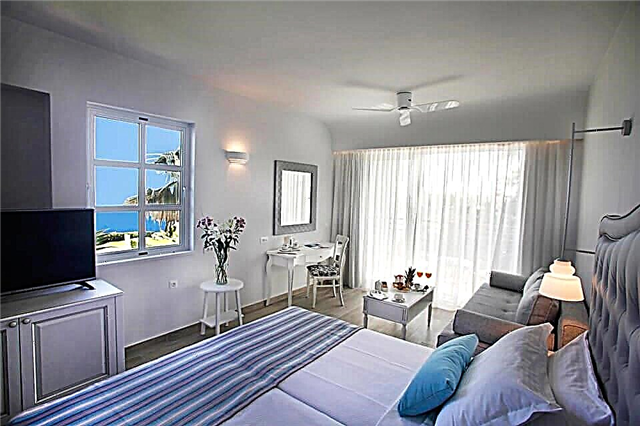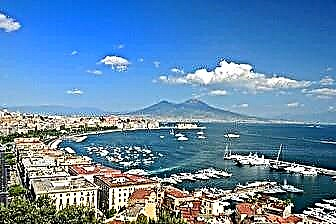The colorful and expressive Naples evokes ambiguous feelings. The magnificent cathedrals and palaces of the Neapolitan kings stand side by side with the poor city blocks, the bright colors of the city streets are replaced by the peeling tiles of dilapidated houses. The Neapolitans themselves are hot-tempered, emotional people and do not like to bother themselves with unnecessary worries.
Yet Naples is a true architectural delight and an unforgiving power of history. On the shores of the Gulf of Naples, Roman civilization flourished, Vesuvius erupted and the geniuses of the Renaissance were created. The city has absorbed the history of entire eras and is now ready to share it with everyone. Local cuisine and excellent wine attract not only foreigners, but even Italians from other parts of the country.

The best hotels and hotels at affordable prices.
from 500 rubles / day
What to see and where to go in Naples?
The most interesting and beautiful places for walking. Photos and a short description.
Mount Vesuvius
An active volcano of the Apennine Mountains system. The history describes 80 eruptions of Vesuvius, but the most destructive happened in 79. As a result, several Roman cities were destroyed and buried under the ashes. In the XIX and XX centuries. Several attempts were made to organize lifts to the volcano for tourists, but all structures were destroyed by another eruption. Nowadays, you can climb Vesuvius along a hiking trail.

Pompeii
Ancient Roman city founded in the 6th century BC. by the italic people of the Oscans. In the 1st century BC. Pompeii fell under the rule of Rome. In 79, as a result of the powerful eruption of Vesuvius, the city was completely buried under ash, several thousand inhabitants died. Excavation of the area began in the 18th century. As a result, Pompeii was literally "dug out" from under a thick layer of ash. Nowadays, a historical park-museum is open on the territory.

Herculaneum
Another ancient city that suffered in 79 due to the volcanic activity of Vesuvius. It was not only covered with ash, but also flooded with streams of lava and liquid mud, which gushed from the sky along with the rain. Most of the population managed to escape. Organized excavations began in 1738 at the initiative of King Charles III. A museum was opened in the nearest town, where the found exhibits were delivered. The buildings and interiors of the houses of Herculaneum are well preserved thanks to the hardened lava.

Piazza del Plebisito
The main city square of Naples, located near the port. Around it are the main attractions of the Middle Ages and Modern times. The piazza acquired its modern shape in the 17th century, when several palaces were built around it. The square was named in honor of the 1860 referendum in which the inhabitants of Naples voted to become part of the Piedmont region.

Royal Palace
Residence of the Spanish governor of Naples, Fernando Ruiz de Castro. Kings and other crowned persons used the palace during their visits to the city. The building was damaged in a fire in 1837, after which a grandiose reconstruction followed. At the end of the 19th century, statues of famous Neapolitan rulers were installed on the facade. A separate wing of the palace houses the library of Victor Emmanuel III.

Basilica of San Francesco di Paola
Church of the XIX century in the neoclassical style, erected under the ruler Ferdinand I. The temple is dedicated to St. Francis. The king believed that it was he who helped to recapture the lands seized by the French and regain the crown. The outlines of the building repeat the architecture of the Roman Pantheon, the cathedral altar of the basilica is lavishly decorated with precious stones, the floor is tiled with marble slabs.

Chapel of San Severo
In the past, the chapel was a private church and the tomb of the noble San Severo family. The first duke of this family, Giovanni Francesco Paolo de Sangro, built a temple in gratitude to Madonna for a miraculous cure from a serious illness. Among the local residents, it is believed that one of the dukes of San Severo was the Grand Master of the Neapolitan Masonic lodges, and the chapel until the middle of the 18th century was the temple of the "society of free masons".

Cathedral of Saint Januarius
Temple dedicated to the patron saint of Naples St. Januarius. It was founded under King Charles I of Anjou in the 13th century. Unique paintings of the 14th century have been preserved in the cathedral chapel. The most important relic of the cathedral is a 17th century vessel with the blood of St. Januarius, which is frozen. But three times a year, in the presence of a large number of believers, a religious "miracle" occurs, and the blood becomes liquid again.

Santa chiara
A religious complex in honor of St. Clara of Assisi, which includes a monastery, museum and tombs of rulers from the Anjou dynasty. The first temple was built on this site at the beginning of the XIV century. In the middle of the 18th century, reconstruction was carried out, and the Baroque became the predominant style in the architecture of the complex. In 1943, as a result of bombing, the church was destroyed, but in 1953 it was restored to its original appearance in the 14th century.

Gallery Umberto I
A 19th century shopping arcade in a neoclassical style with neo-Renaissance elements, a wonderful example of modern urban architecture. When designing, the Milan gallery of Victor Emmanuel was taken as a model, but in the end the copy turned out to be more luxurious than the original itself. Inside there are shops and restaurants, and occasionally there are concerts of piano music.

Capodimonte Museum
Neapolitan Museum of Fine Arts, which houses the largest collection of Titian. Most of the exhibition was collected by representatives of the Farnese family, from where Pope Paul III emerged. The pontiff constantly ordered paintings from Michelangelo and Titian, who created portraits of almost all members of the Farnese family. In the 18th century, a separate palace was built for the collection.

Archaeological Museum of Naples
Museum containing finds from the excavations of Herculaneum, Pompeii and Stabia. The exposition is housed in a building of the 16th-17th centuries. Initially, this building served as a university, then the private collection of the Bourbons and Farnese, as well as the royal library, were moved here. The most valuable exhibits are works of art created by ancient masters. They were recovered from the rubble of the cities destroyed by the eruption.

Opera House of San Carlo
The theater was built under Charles III of Bourbon in the first half of the 18th century. The building accommodated more than 3 thousand spectators, making the Neapolitan opera stage the largest in the world. The historical building has not survived to this day, as it was destroyed by a fire in 1816 and finished off by bombing in 1943. In addition to performances, tourists have the opportunity to visit the theater with a guided tour.

Castle of Castel del Ovo
A coastal fortification whose powerful walls cut into the waters of the Tyrrhenian Sea. The fortress stands on a small island and looks like a huge stone ship from afar. The first building on this site was the villa of the Roman commander Lucullus. In the 5th century, the building was fortified in case of an attack on the city from the sea. Until the 9th century, monks lived on the island. The castle expanded over the following centuries, in the 17th century it was converted into a prison. A fortress built at the beginning of the 12th century has survived to this day.

Castle of Sant Elmo
The fortress is built on a hill and therefore dominates the cityscape. The castle walls offer a mesmerizing panorama of Vesuvius and picturesque views of Naples. The castle was built on the site of a 10th century church. In the 16th century, the Spaniards rebuilt the fortress and since then its appearance has remained practically unchanged. Over the centuries, the fortification has been repeatedly sieged and assaulted due to its advantageous strategic position.

Castle of Castel Nuovo
The palace built for Charles of Anjou in the 13th century. The monarch was never able to settle in it, as he was killed during the uprising. The building combines the inaccessibility of formidable fortifications and the luxury of a royal residence. The castle was alternately owned by the French, Spanish and Austrians. At the beginning of the 19th century, he even visited the hands of a Russian squadron. Today, the site houses a museum and the headquarters of the historical society.

Royal Palace of Caserta
Country palace of the Neapolitan rulers, built in the 18th century. It is 3.5 times larger than the French Versailles. The palace was built according to the project of L. Vanvitelli. In planning, the architect took the Royal Palace of Madrid as a model. On the territory there is a court theater and a church. It was planned to build another library and a university, but these plans remained on paper.

Fontanelle cemetery
An ossuary (ossuary) located in caves on the slopes of Materdey Hill. The first burials appeared here in the middle of the 17th century, when hundreds of people died every day as a result of the plague epidemic. Later, the remains of the poor, who did not have enough funds for burial, began to be brought here. The last corpses were brought here in 1837. The cemetery began to be improved at the end of the 19th century. In the 21st century, visitors were allowed to enter.

Catacombs of San Gaudioso
A complex of underground labyrinths, which began to form from the 2nd century AD. Here the first Christians took refuge from persecution. In the catacombs, the followers of Jesus buried the dead, held services, organized underground temples. Ancient paintings and mosaics have been preserved on the walls. On one of the upper levels is the grave of the Neapolitan patron and protector of St. Januarius.

Gulf of Naples
Gulf on the Tyrrhenian Sea, washing the western coast of Italy. Thanks to the excellent climate and excellent living conditions, these places have been inhabited since ancient times. The islands of the Gulf of Capri and Ischia are considered excellent places for a beach holiday. From the shores of the Gulf of Naples, picturesque views of the Vesuvius volcano, Naples and the endless expanses of the Tyrrhenian Sea open up.












